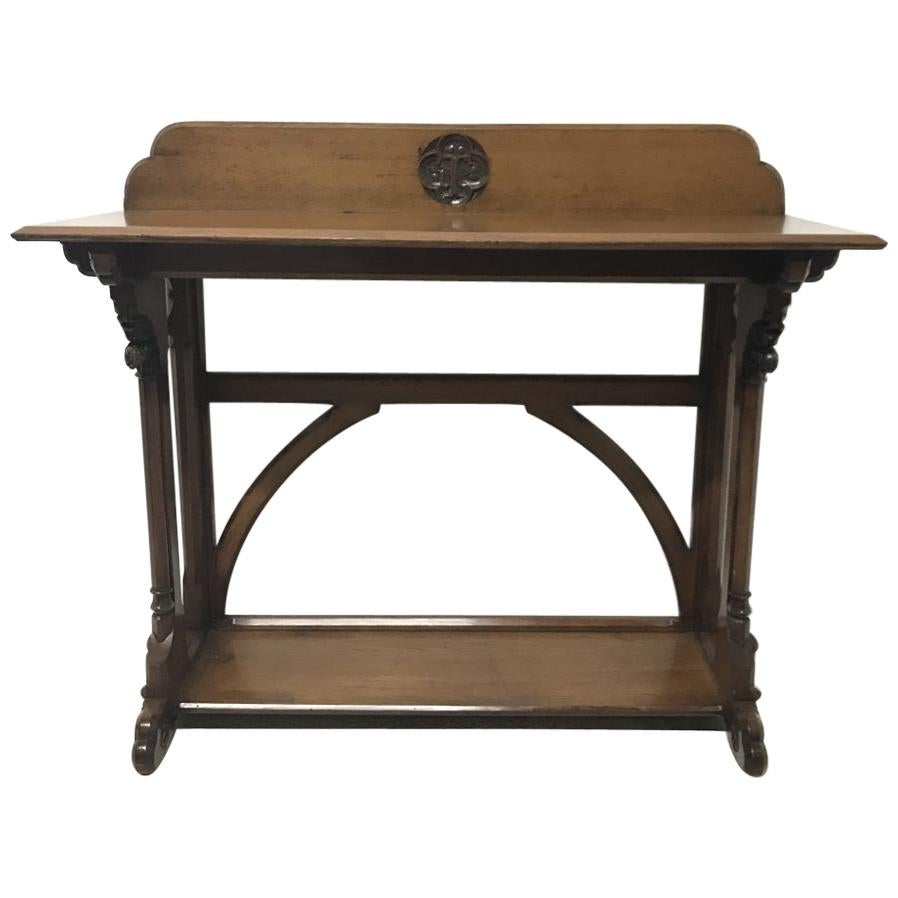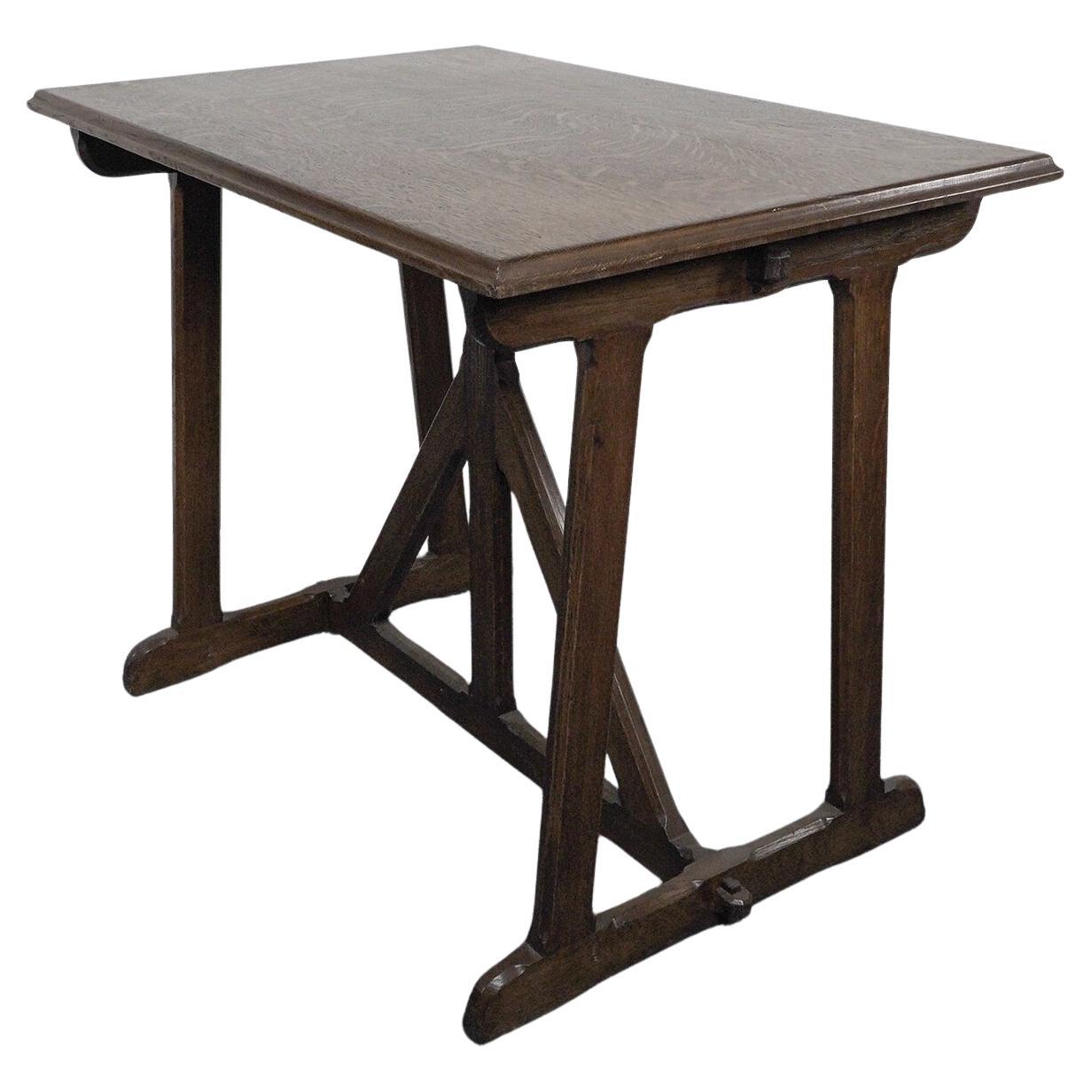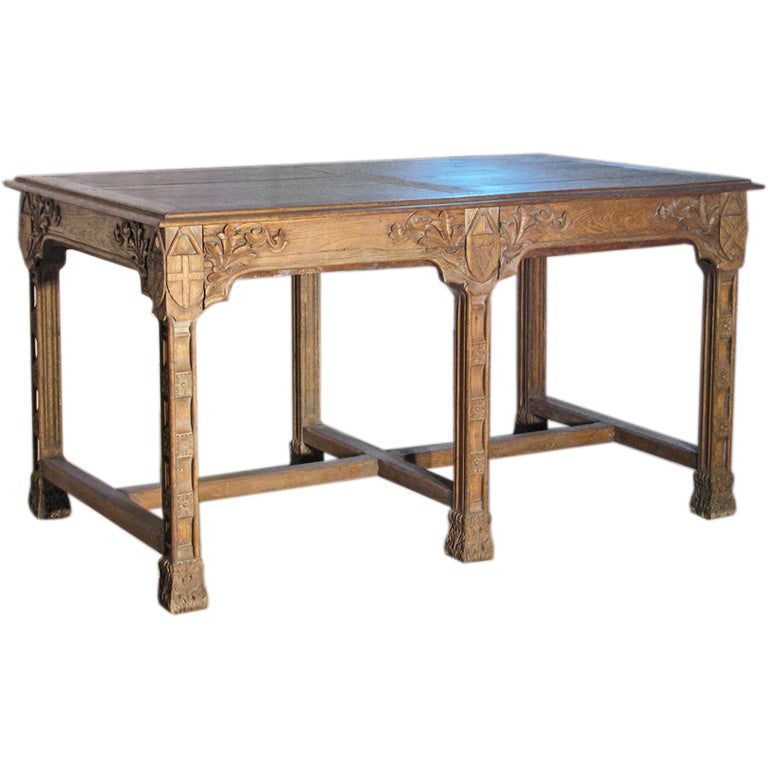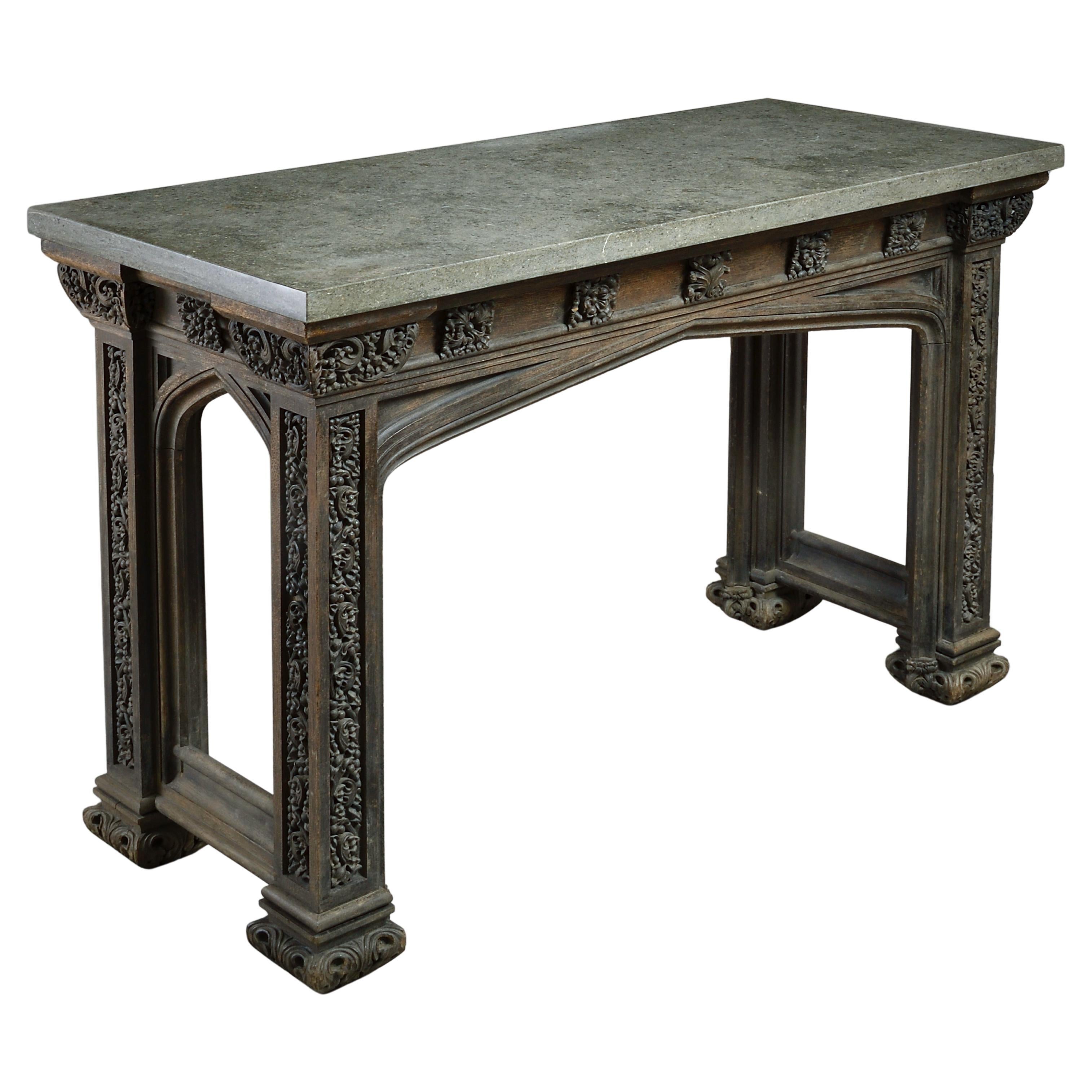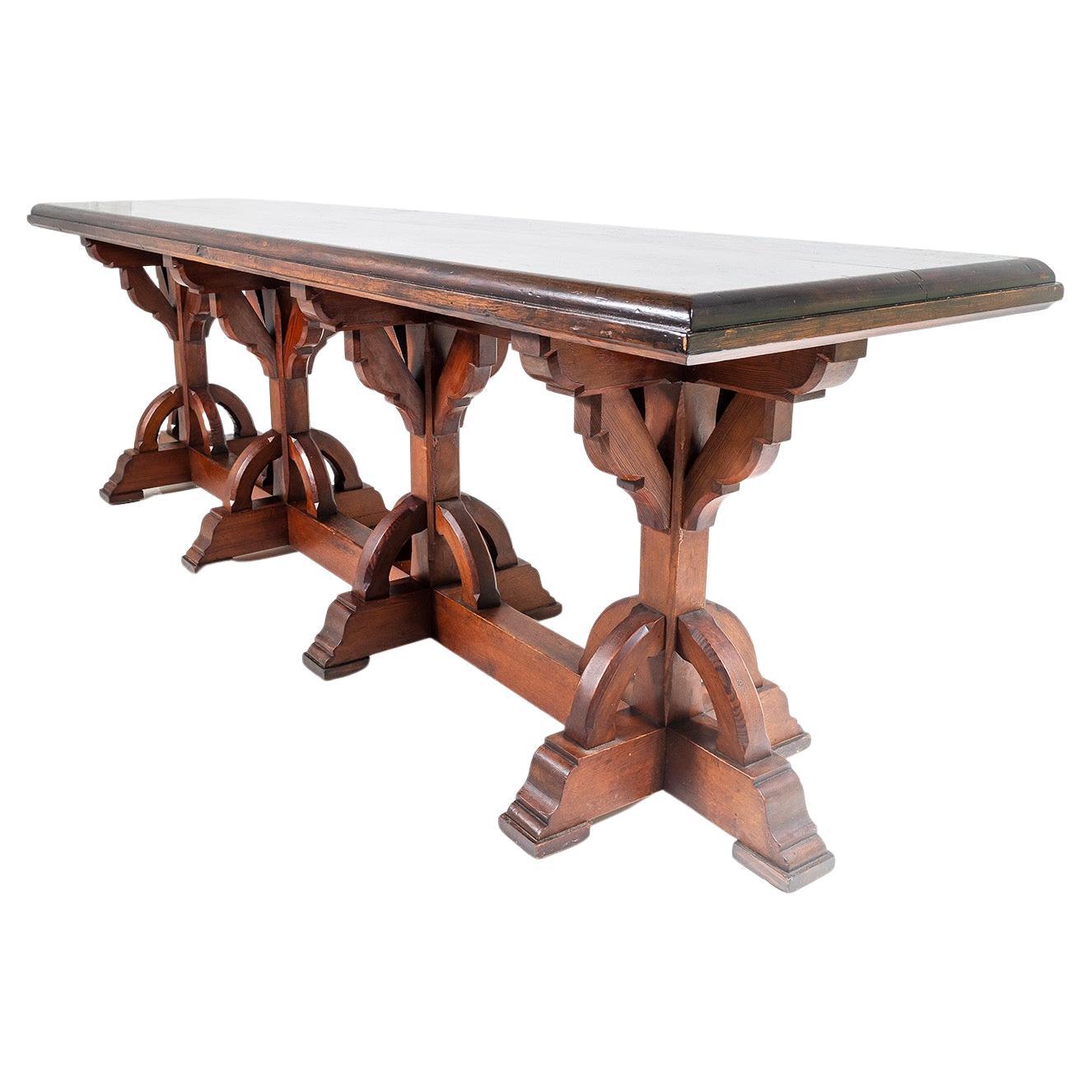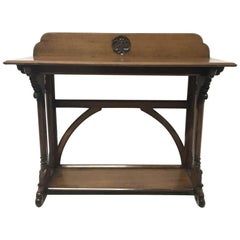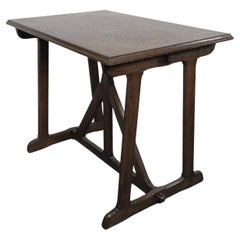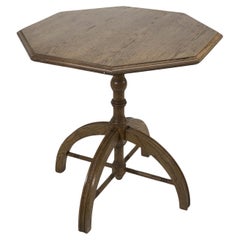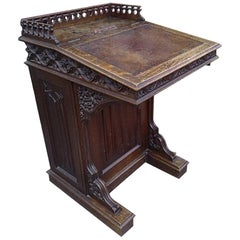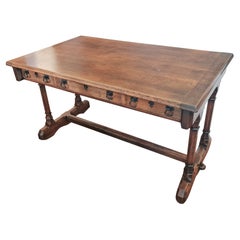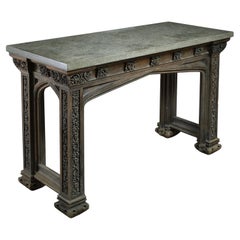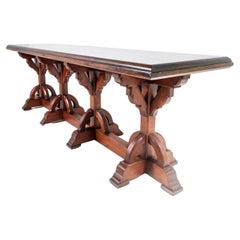Items Similar to A.W.N Pugin and Sir Charles Barry, an Important Gothic Revival Oak Library Table
Want more images or videos?
Request additional images or videos from the seller
1 of 21
A.W.N Pugin and Sir Charles Barry, an Important Gothic Revival Oak Library Table
$80,113.52
£60,000
€69,429.50
CA$112,883.48
A$124,295.57
CHF 64,452.69
MX$1,472,001.26
NOK 818,185.60
SEK 764,687.16
DKK 518,556.15
About the Item
A.W.N Pugin and Sir Charles Barry.
A rare and important Gothic Revival carved oak library table. Probably one of the earliest known pieces to derive from the illustrious relationship with Sir Charles Barry, some five years before they began work on the Houses Of Parliament together. Sir Charles Barry designed the relatively simple Tudor Gothic/Elizabethan house East Horsley Park for William Currie in 1834. Pugin, from April 1835 worked for Barry, assisting him with some of the interiors, including furniture of his (Barry’s) King Edward VI Grammar School Birmingham. Pugin assisted Barry with Trentham Church and with the interior of Horsley Towers for Currie; this being first noted by Phoebe Stanton in her Courtauld Institute Ph.D on Pugin (1950).
The Currie family sold the estate in the early 1840s to the eccentric Lord Lovelace (1805-1893) who (Sir John and Lady Kirkland who were tenants having moved out in early 1845) lived there from circa 1846 to his death and was responsible for the fanciful Gothic/Byzantine work there (Great Hall is dated 1847 and west tower is of late 1840s, east tower 1858 and cloisters 1859. The chapel is 1860 and an additional storey to the south side was also added by Lovelace. Lovelace’s style in the late 1850s is clearly very different (in part due to his having travelled abroad) to his earlier work at the house.
Phoebe Stanton was the first to state Pugin worked for Barry on the interiors/furniture at East Horsley Park in her 1950 Ph.D. It has therefore been generally known that Pugin worked for Barry on East Horsley Park.
David Blissett included this project in his own Ph.D of 1984, in which he included the illustrations attached of Barry’s scheme of the house and a tracing of what is clearly a group of designs for furniture by Barry/Pugin. Given the design, date and scale of the furniture in these tracings it has been suggested they were for the relatively small-scale East Horsley Park and are by Barry/Pugin circa 1835. Before Lovelace took up residence the house was let out, but it is not clear yet whether it was let out by the Curries or Lovelace. One of the points to note in the lettings details is that it was to be let furnished. David therefore strongly suspects some of the Barry/Pugin furniture that was specifically designed for the house circa 1835 was left in the house not only when it was let, but when it was sold to Lovelace circa 1840. Lovelace, in his inimitable manner, then proceeded 1847/8 to reinvent, much to Barry’s horror, the relatively modest Gothic house Barry had created for Currie. Barry was so annoyed by this vandalism that he turned his back on the project.
The 1st Earl of Lovelace was raised to that Peerage in Queen Victoria's Accession Honours list of 1838. Three years earlier in 1835 Lovelace married Ada Byron, becoming Countess of Love. She was the only daughter of the celebrated poet Lord Byron. She was an important figure, a mathematician and writer, who is known for her work on Charles Babbage's early mechanical computer and is often regarded as the first computer programmer. Ada described in her notes how codes could be created for the device to handle letters and symbols along with numbers. She also theorized a method for the engine to repeat a series of instructions, a process known as looping that computer programs use today. Ada also offered up other forward-thinking concepts in the article.
In her later years, she tried to develop mathematical schemes for winning at gambling. Unfortunately, her schemes failed and put her in financial peril.
Ada died in 1853 at the age of 37.
I would like to thank David and Rachel Blissett for the information regarding Barry and Pugin working together on East Horsley Park and for the drawings and paragraphs in the images.
I have hard copies of the original drawings from David and Rachel Blissett and the furniture drawings (as shown in this listing) which prove this desk is part of the East Horsley Park commission. I also have emails from David and Rachel Blissett to me confirming the attribution to AWN Pugin which will be included in the sale of this highly important early Gothic Revival desk.
- Creator:Augustus Welby Northmore Pugin (Designer)
- Dimensions:Height: 31 in (78.74 cm)Width: 60 in (152.4 cm)Depth: 34 in (86.36 cm)
- Style:Gothic Revival (Of the Period)
- Materials and Techniques:
- Place of Origin:
- Period:
- Date of Manufacture:1835
- Condition:Wear consistent with age and use. The leather top has been replaced. The fabric on the floor stretcher is original. Small chip to one foot just up from the Tudor rose.
- Seller Location:London, GB
- Reference Number:1stDibs: LU2243312592871
About the Seller
5.0
Platinum Seller
Premium sellers with a 4.7+ rating and 24-hour response times
Established in 1989
1stDibs seller since 2016
303 sales on 1stDibs
Typical response time: 1 hour
- ShippingRetrieving quote...Shipping from: London, United Kingdom
- Return Policy
More From This Seller
View AllA.W.N. Pugin, J C Crace Gothic Revival Carved Oak Library, Hall or Serving Table
By Augustus Welby Northmore Pugin
Located in London, GB
A.W.N. Pugin. A rare Gothic Revival carved oak library or serving table with floor level display shelf. Probably made by J C Crace.
Pugin used a number of recurring motifs, on furnit...
Category
Antique 1850s English Gothic Revival Serving Tables
Materials
Oak
A W N Pugin, after a design by. A late 20th Century Gothic Revival oak table
By Augustus Welby Northmore Pugin
Located in London, GB
A. W. N. Pugin, after a design by. A late 20th Century Gothic Revival oak table. Of the type that Pugin instructed was to be made for "poor vicars". He asked the furniture maker John...
Category
1990s English Gothic Revival Side Tables
Materials
Oak
A W N Pugin. A modern craftsman made Gothic Revival oak octagonal centre table
By Augustus Welby Northmore Pugin
Located in London, GB
A W N Pugin after a design by. A modern craftsman made Gothic Revival oak octagonal centre table with a central upright turned column that passes through the arched legs uniting the ...
Category
Vintage 1980s English Gothic Revival Side Tables
Materials
Oak
A W N Pugin Attri, Gothic Revival Oak Davenport with Linenfold & Floral Carving
By Augustus Welby Northmore Pugin
Located in London, GB
A W N Pugin attributed,
A Gothic Revival Oak Davenport with finely executed carved gallery to the top and a sloping writing area opening to reveal storage...
Category
Antique 1860s English Gothic Revival Desks
Materials
Oak
Bruce Talbert for Gillows Attributed Gothic Revival Two-Tier Library Table
By Bruce James Talbert, Gillows of Lancaster & London
Located in London, GB
Bruce Talbert, Attributed, a Gothic Revival walnut library or serving table with turned gallery below the upper serving area, on turned legs with ebonized details united by a full si...
Category
Antique Late 19th Century English Gothic Revival Desks and Writing Tables
Materials
Walnut
E W Godwin for Northampton town hall. A Gothic Revival oak refectory table
By Edward William Godwin
Located in London, GB
E.W. Godwin attributed for Northampton town hall. A gothic revival oak refectory table with cross braced legs united by an upper stretcher.
Category
Antique 1860s English Gothic Revival Dining Room Tables
Materials
Oak
You May Also Like
Gothic Revival oak writing or library table A. W. N. Pugin
By Augustus Welby Northmore Pugin
Located in Tunbridge Wells, GB
Fine 19th Century Gothic Revival oak library table, the design attributed to A. W. N. Pugin and although not stamped was probably made by Gillow or Holland & Sons two of the leading...
Category
Antique Mid-19th Century British Gothic Revival Desks and Writing Tables
Materials
Oak
19th Century Gothic Revival Center Table in the Manner of Pugin
Located in Troy, NY
19th Century Gothic Revival Table in the Manner of Augustus Welby Northmore Pugin (1812-1852). Unusual center table, the rectangular multi-board top above a carved frieze featuring f...
Category
Antique Early 19th Century English Gothic Revival Center Tables
Materials
Oak
Gothic Revival Carved Oak Side Table Possibly Designed by A.W.N. Pugin
Located in London, GB
A FINE GOTHIC REVIVAL CARVED OAK SIDE TABLE POSSIBLY DESIGNED BY A.W.N. PUGIN, CIRCA 1835.
With later Purbeck fossil marble top. The moulded frieze applied with paterae, the panelle...
Category
Antique 19th Century Side Tables
Materials
Marble
Large Scale Victorian Ecclesiastical Gothic Revival Table in the Manner of Pugin
By Augustus Welby Northmore Pugin
Located in Llanbrynmair, GB
A superb 19th century Gothic Revival centre table in the manner of A.W.N Pugin (unattributed). Would make a wonderful serving table or large console table. Narrow form make this piec...
Category
Antique 19th Century British Gothic Revival Center Tables
Materials
Other
19th Century French Napoleon III Period Gothic Revival Walnut Library Table
Located in Dallas, TX
19th Century French Napoleon III Period Gothic Revival Walnut Library Table is an amazing example of the revival of the oldest formal style to originate from France, dating to the mi...
Category
Mid-20th Century French Gothic Revival Center Tables
Materials
Walnut
Gothic Revival Oak Writing Table by J. G. Crace, c.1850
Located in London, GB
A Gothic Revival Oak Writing Table by J. G. Crace, after a design by Pugin
With extensive gothic carving work, the sides with strapwork carving centred by a monogram reading “MP”, t...
Category
Antique 19th Century Gothic Revival Desks and Writing Tables
Materials
Oak
More Ways To Browse
Carved Gothic Table
Antique Gothic Desk
Gothic House
Library Table Oak Carved
Gothic Writing Desk
Gothic Library
Edward Vi
Carved Gothic Desk
Antique Gothic Library Tables
Gothic Revival Library Table
Antique Mission Oak Desk
Italian Writing Desk With Inlay
Solid Walnut Desk
Stickley Desk
1930s Writing Desk
Art Deco Desk Oak
French Barley Twist Furniture
Empire Writing Desk

